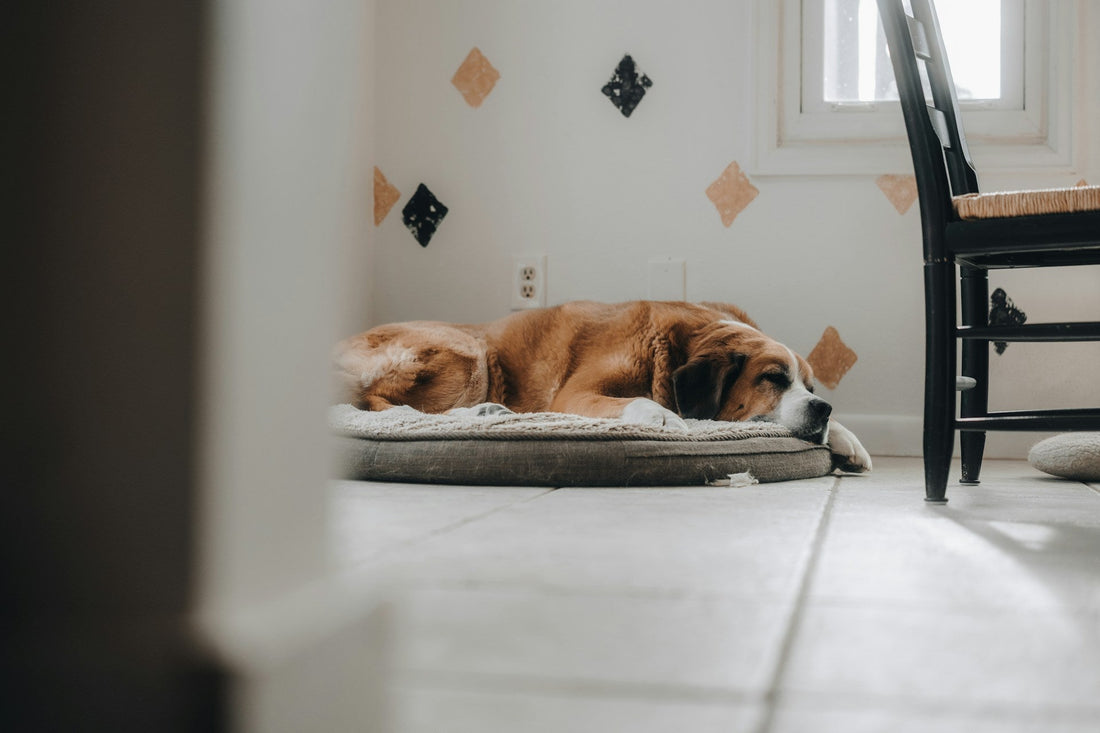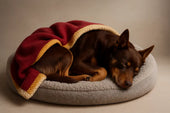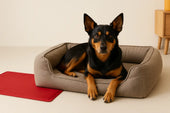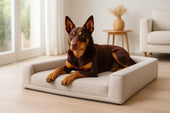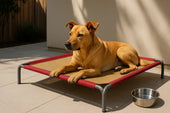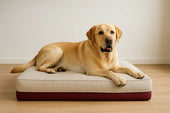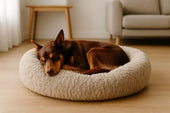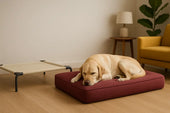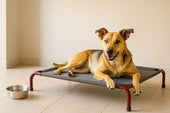Key Takeaways
- Hypoallergenic dog beds can significantly reduce skin irritation and allergy symptoms in dogs with sensitive skin, especially in Australia’s challenging climate.
- The choice of materials matters: Opt for tightly-woven cotton, bamboo, natural latex, or certified hypoallergenic fabrics; avoid synthetic fillers and beds with harsh chemical treatments.
- Regular cleaning and maintenance are as crucial as the bed itself—weekly washing and safe, pet-friendly detergents help prevent allergen build-up.
- Elevated, minimalist, and orthopedic beds with removable covers are among the best designs for sensitive dogs.
- Expert advice and real-life stories from Australian pet owners and vets highlight practical solutions for keeping pets comfortable and healthy.
- Look beyond the bed: Maintaining a clean, allergy-friendly home, combined with good grooming and veterinary care, gives sensitive dogs the best chance for a happy, itch-free life.
Tail-Wagging Favourites from PetCareShed
Introduction
Australia’s pet owners are renowned for treating their dogs as part of the family. But what happens when your beloved companion develops itchy, irritated skin—or worse, shows signs of allergies? For many dogs, sensitive skin isn’t just a minor nuisance; it can disrupt their sleep, happiness, and overall health.
One of the most overlooked triggers for canine allergies and skin sensitivities is your dog’s bed. While a soft, cosy bed should be a haven for rest, the wrong bedding can harbour dust mites, mould, harsh chemicals, and irritant fibres. In recent years, the demand for hypoallergenic dog beds has surged as more Australian owners seek safe, gentle sleeping solutions for their pets.
But what does “hypoallergenic” really mean when it comes to pet beds? Are the claims on the label legitimate, and how can you be sure you’re choosing the right option for your dog? This article provides an in-depth look at allergy-friendly dog beds—explaining the science, sharing expert tips, and spotlighting the best choices for Australian conditions.
With clear, practical advice tailored to grade 10 reading level and informed by local veterinary expertise, this guide will help you confidently select and maintain a dog bed that truly supports your pet’s sensitive skin.
Understanding Sensitive Skin and Allergies in Dogs
Sensitive skin and allergies are increasingly common in Australian dogs, affecting everything from their comfort to their long-term health. Recognising the signs and understanding the causes is the first step to managing the problem—and choosing the right bed can play a surprisingly big role.
Common Causes of Sensitive Skin and Allergic Reactions
Dog skin is thinner and more exposed to environmental irritants than human skin. Here are some of the most frequent triggers for canine skin sensitivity and allergies:
- Environmental factors: Pollen, dust mites, mould, and grass—all prevalent across Australian regions—can stick to bedding and cause flare-ups.
- Food allergies: Certain proteins or additives can cause reactions that show up as skin irritation.
- Fleas and parasites: Even a few bites can trigger intense itching and secondary infections.
- Harsh chemicals: Detergents, cleaning agents, and bedding materials treated with anti-fungal or flame-retardant chemicals can irritate sensitive dogs.
- Contact allergies: Some dogs react to specific fabrics or materials, such as wool, synthetic fibres, or rubber.
Symptoms to Watch For
If your dog has sensitive skin or allergies, you may notice:
- Persistent itching, licking, or chewing at the skin
- Red, inflamed patches or rashes
- Hair loss or bald spots
- Chronic ear infections
- Dry, flaky, or oily skin
- Unpleasant odour from the skin or ears
Symptoms can range from mild discomfort to severe distress. If you see these signs, consult a vet for a diagnosis and tailored treatment.
Insights from Australian Veterinarians
Australian vets have observed an uptick in allergy-related cases, especially in urban areas where pets spend a lot of time indoors and are exposed to dust mites and indoor allergens.
Dr. Andrew Marchevsky, veterinary dermatologist at Small Animal Specialist Hospital Sydney, notes:
“We’re seeing more pets with chronic itching and skin conditions, often linked to environmental allergens that are easily overlooked, like pet bedding. Identifying and reducing exposure to these triggers can make a significant difference.”
Why Bedding Matters
Your dog spends many hours on its bed, and skin has close, prolonged contact with whatever materials and contaminants are present. Allergens accumulate in the fibres and filling, and beds that are hard to wash or slow to dry can worsen the problem.
By recognising the role bedding plays in your dog’s skin health, you can take informed steps to reduce discomfort and prevent ongoing issues.
PetCareShed’s Expert Picks for Happy, Healthy Dogs
How Dog Beds Can Affect Sensitive Skin and Allergies
A dog’s bed is supposed to be a place of comfort and safety, but for dogs with sensitive skin or allergies, it can become a persistent source of irritation. Understanding how bedding materials, environmental factors, and even cleaning routines can impact your pet is essential for every Australian dog owner.
Materials and Fillers That Can Trigger Skin Irritation or Allergic Reactions
The material of your dog’s bed is a crucial factor in managing allergies. Common irritants include:
- Synthetic fabrics and loose fillers: Polyester, nylon, and acrylic can trap moisture and heat, creating a breeding ground for bacteria and dust mites. Some synthetic fillers can also break down over time, releasing microscopic fibres that irritate skin.
- Chemically treated fabrics: Beds treated with flame retardants, anti-mould chemicals, or insecticides may leave residues that can cause contact dermatitis, especially in dogs with pre-existing sensitivities.
- Natural fibres: While some dogs tolerate cotton or hemp well, others may be sensitive to untreated wool or fibres processed with harsh chemicals.
The Role of Dust Mites, Mould, and Chemical Residues
- Dust mites thrive in warm, humid conditions—common in many parts of Australia. Their droppings are one of the leading causes of skin and respiratory allergies in both dogs and humans.
- Mould and mildew develop easily in beds that remain damp, either from saliva, accidents, or high humidity. Invisible to the naked eye, mould spores can quickly exacerbate skin problems and trigger itching or rashes.
- Chemical residues from manufacturing or cleaning products can linger in bedding, causing ongoing irritation or allergic reactions.
Dr. David Hughes, an Australian veterinary dermatologist, explains:
“Many pet beds contain hidden allergens or residues that aren’t obvious to the eye or touch. Sensitive-skinned dogs are often the first to show you when something in their environment isn’t right.”
The Impact of Climate (Humidity, Temperature) on Bedding and Allergies in Australia
Australia’s climate is highly variable—ranging from tropical and humid in the north to cool and damp in the south. High humidity accelerates dust mite and mould growth, while cold or wet weather makes it harder for beds to dry thoroughly after washing.
This means the risk of allergen build-up in your dog’s bed is higher in places like Brisbane, Cairns, or Sydney compared to drier regions. Regular cleaning and quick-drying, breathable bedding materials are especially important for allergy-prone dogs in humid Australian environments.
Why Even Clean Beds Can Cause Problems
Washing a bed doesn’t always remove every allergen—especially if the materials are difficult to dry or have deep seams and stuffing where moisture and dust mites hide. Using scented or harsh detergents can also leave irritating residues.
In summary, the best dog beds for sensitive skin minimise allergen build-up, avoid harsh chemicals, and are easy to keep clean and dry—even in Australia’s challenging climate.
What Makes a Dog Bed Hypoallergenic?
With rising awareness of pet allergies, the term “hypoallergenic” is appearing on more dog bed labels. But what does it really mean, and how can you tell if a bed will genuinely help your sensitive dog?
Definition and Standards: What Qualifies as Hypoallergenic for Pet Beds
A hypoallergenic dog bed is designed to minimise the risk of allergic reactions by:
- Using materials less likely to trigger skin irritation or respiratory symptoms
- Resisting dust mite and mould accumulation
- Being free from harsh chemical treatments and fragrances
- Featuring construction that allows for easy, effective cleaning
Unlike human bedding, there’s no single government-regulated standard for “hypoallergenic” in the Australian pet industry. This means it’s essential for pet owners to look beyond marketing and check for specific features or third-party certifications.
Key Features of Hypoallergenic Beds
The most effective hypoallergenic dog beds typically offer:
- Tightly-woven or dense outer fabrics (like microfibre or cotton) that block dust mites and dander
- Smooth, removable, and machine-washable covers for thorough, frequent cleaning
- Minimal seams, zippers, or buttons where allergens can collect
- Natural, untreated fillings (like latex or specific foams) instead of loose synthetic stuffing
- Moisture-wicking and quick-drying properties to prevent mould and mildew
The Difference Between Marketing Claims and Real Benefits
Not all “hypoallergenic” dog beds are created equal. Some products are labelled hypoallergenic based solely on one feature, such as a washable cover, but may still contain irritant fillers or chemical treatments.
Dr. Sarah Howard, Australian Veterinary Association, advises:
“The best hypoallergenic dog beds are those that combine safe, non-irritant materials with designs that make them easy to keep clean and dry. Look for specific details, not just marketing buzzwords.”
Certifications and Standards to Look For
- Oeko-Tex® Standard 100: International certification ensuring textiles are free from harmful chemicals.
- Australian Made Certification: Indicates local manufacturing and often better control over material sourcing and treatment.
- Hypoallergenic Claims: Seek out brands that specify how and why their beds are allergy-friendly, with transparent information on materials and care.
Why It Matters for Sensitive Dogs
Hypoallergenic dog beds help prevent the “allergy cycle”—where skin irritation from allergens leads to scratching, broken skin, infection, and even more severe reactions. The right bed won’t cure allergies, but it can dramatically improve your dog’s comfort and quality of life.
Best Hypoallergenic Materials for Dog Beds
The materials that make up a dog bed are at the heart of allergy prevention. Choosing the right fabrics and fillings can make a significant difference for dogs with sensitive skin—and help keep the entire household healthier.
Detailed Overview of Top Allergy-Friendly Materials
Tightly-Woven Cotton and Microfibre
- Cotton: Natural, breathable, and gentle on sensitive skin. Opt for organic or unbleached cotton to avoid harsh chemicals. Tightly-woven cotton resists dust mites better than loosely woven varieties.
- Microfibre: A synthetic alternative that’s smooth, tightly woven, and resistant to dust mite infiltration. It’s also quick to dry, making it ideal for humid Australian climates.
Natural Latex and Wool
- Natural latex: Sourced from rubber trees, latex is naturally hypoallergenic, resistant to dust mites, and doesn’t retain moisture like synthetic foams. Ensure the latex is untreated and free of added chemicals.
- Wool: While some dogs (and people) are allergic to wool, high-quality, untreated wool is naturally resistant to dust mites and mould. Merino wool, produced in Australia, is soft, temperature-regulating, and suitable for many sensitive dogs. However, always test for reactions before using wool.
Bamboo, Hemp, and Other Plant-Based Fabrics
- Bamboo: Known for its softness, antibacterial properties, and moisture-wicking ability. Bamboo fibres are increasingly used in hypoallergenic bedding and are environmentally sustainable.
- Hemp: Strong, naturally mildew-resistant, and becomes softer with washing. It’s a good option for dogs with severe allergies, provided it’s processed without harsh chemicals.
- Other options: Linen and Tencel (eucalyptus fibre) are becoming more popular for pet bedding, offering smooth surfaces that resist allergen build-up.
Memory Foam (Pros and Cons)
- Pros: High-density memory foam can provide excellent orthopedic support, which is great for older or arthritic dogs. When paired with a hypoallergenic, washable cover, it can be suitable for sensitive pets.
- Cons: Foam can trap moisture and heat if not properly ventilated. Always use a waterproof or moisture-wicking cover to prevent mould and dust mite growth.
Materials to Avoid
- Loose synthetic fillers: Such as polyester fibre, which traps dust mites, moisture, and dander.
- Plush or high-pile fabrics: These can be difficult to wash thoroughly and can retain allergens.
- Chemically treated fabrics: Avoid beds with stain-resistant, anti-bacterial, or flame-retardant treatments unless certified safe for sensitive skin.
Local (Australian) vs. Imported Options
- Australian-made beds often use locally sourced, high-quality wool, cotton, or bamboo, with clearer information on material safety and manufacturing standards.
- Imported beds may have less transparency around chemical treatments and material sourcing. Always read labels and check for certifications.
Dr. Rachel Allavena, associate professor at The University of Queensland School of Veterinary Science, advises:
“Australian-made beds using untreated wool, cotton, or bamboo are an excellent choice for sensitive dogs, as they combine safety, comfort, and environmental sustainability.”
Expert Tips for Choosing the Right Bed for Sensitive Skin
Selecting a dog bed for sensitive skin requires more than just looking for the “hypoallergenic” label. Here’s what experts recommend you do before buying, so you can be sure you’re making the healthiest and safest choice for your dog.
What to Look for When Shopping
- Removable, machine-washable covers: Essential for frequent, thorough cleaning. The easier it is to wash all parts of the bed, the better for allergy control.
- Dense, smooth fabrics: Tightly-woven cotton, bamboo, hemp, or microfibre are less likely to trap dust mites or dander than plush or shaggy fabrics.
- Minimal seams and crevices: Fewer folds, tufts, and zippers mean fewer places for allergens to accumulate.
- Supportive base: Orthopedic memory foam (with protective covers) or natural latex offer both comfort and allergy resistance.
- Certifications: Look for Oeko-Tex®, Australian Made, or other relevant standards that assure low chemical content and material safety.
How to Read and Interpret Labels and Claims
- Be wary of vague “hypoallergenic” claims: Look for specific information about materials, treatments, and certifications.
- Check for “untreated” or “organic” materials: Beds labelled “untreated,” “organic cotton,” or “natural latex” are less likely to contain harsh chemicals.
- Investigate manufacturing origins: Locally made beds generally have clearer disclosure and must comply with Australian standards.
- Ask about warranty and trial periods: Reputable Australian brands often offer a satisfaction guarantee, letting you return the bed if your dog reacts poorly.
Questions to Ask Manufacturers or Retailers
- What specific materials are used for the cover and filling?
- Are there any chemical treatments, dyes, or flame retardants used?
- Is the bed recommended for dogs with allergies or sensitive skin?
- How should the bed be cleaned for best results?
- Is the bed manufactured in Australia, and does it have relevant certifications?
Angela Anderson, founder of the Australian Pet Owners Association, notes:
“Transparency is key. A company willing to share details about materials and care instructions is far more likely to offer a genuinely hypoallergenic product than one that relies on generic buzzwords.”
Additional Pro Tips
- Test before fully committing: If possible, introduce new bedding slowly to watch for reactions.
- Rotate beds: Having two beds allows you to wash one while your dog uses the other, keeping allergens to a minimum.
- Keep receipts and documentation: If your dog has a severe allergy or skin condition, keeping product info on hand can help if you need to consult your vet.
Top Allergy-Friendly Dog Bed Designs for Australian Homes
Not all dog beds are created equal when it comes to minimising allergens and supporting sensitive skin. The design of a bed influences how easily it can be cleaned, how well it resists dust mites and mould, and how comfortable it is for your dog—especially in the varied climates found across Australia.
Raised/Elevated Beds
What they are:
Beds with a sturdy frame (often metal or plastic) and a taut, breathable fabric sleeping surface.
Benefits:
- Keeps your dog off the floor, reducing contact with dust, pollen, and mites.
- Air circulates underneath, helping bedding stay dry and mould-free.
- Minimal crevices, making cleaning easier.
Best for:
Outdoor use, hot or humid climates, and dogs prone to overheating or allergies.
Orthopedic Beds with Washable Covers
What they are:
Supportive beds, often made from memory foam or latex, covered with removable and washable fabric.
Benefits:
- Excellent for older dogs or those with joint issues.
- Removable covers make cleaning convenient.
- When paired with hypoallergenic covers, these beds can be both supportive and allergy-friendly.
Best for:
Seniors, dogs with arthritis, or any breed needing extra support.
Minimalist or Single-Piece Beds
What they are:
Beds made from a single block of foam or dense padding, usually with a removable, washable cover and minimal seams.
Benefits:
- Fewer places for allergens to hide.
- Simple construction makes thorough washing easy.
- Less risk of stuffing coming loose and harbouring mites.
Best for:
Allergies and sensitive skin, homes wanting quick cleaning routines.
Portable/Travel Hypoallergenic Beds
What they are:
Compact, foldable beds made from hypoallergenic materials, designed for travel or temporary use.
Benefits:
- Allows dogs with sensitive skin to have a safe place to rest wherever they go.
- Easy to wash and pack for trips.
Best for:
Active families, travel, and outings with allergy-prone pets.
Pros and Cons of Each Style
| Bed Style | Pros | Cons |
|---|---|---|
| Elevated | Great airflow, easy to clean, outdoor-ready | May not suit dogs that like plush comfort |
| Orthopedic (washable) | Supportive, removable covers, hypoallergenic | Foam needs to be kept dry |
| Minimalist/single-piece | Simple, easy to clean, no loose stuffing | May not offer high sides for nesting dogs |
| Portable/travel | Convenient, allergy-friendly, versatile | Less padding/support for long-term use |
Quote from an Australian Pet Bedding Specialist:
Lisa Tran, founder of Snooza, says:
“For dogs with allergies, design simplicity is your friend. Look for beds with minimal seams and components, and always choose options that can be completely washed and dried.”
Cleaning and Maintenance: Keeping Hypoallergenic Beds Truly Allergy-Free
Choosing the right hypoallergenic bed is only the first step—keeping it clean and well-maintained is just as important for preventing flare-ups of sensitive skin or allergies. In Australia’s climate, allergens can build up quickly, so a consistent cleaning routine is vital.
How Often to Clean and Recommended Washing Methods
- Weekly washing: Launder your dog’s bedding (including all removable covers and blankets) at least once a week. During allergy season or in humid regions, increase the frequency to every few days.
- Hot water: Use water above 55°C to kill dust mites and break down allergens effectively.
- Thorough drying: Dry bedding completely, ideally in direct Australian sunlight or on a high-heat dryer setting. Sunlight naturally helps kill bacteria and dust mites.
Dr. Justine Lee, DVM, advises on Pet Health Network:
“Frequent and thorough cleaning of pet beds is one of the most effective ways to control allergies, fleas, and skin irritation in sensitive dogs.”
Safe Cleaning Products for Sensitive Dogs
- Choose pet-safe, fragrance-free detergents: Look for products labelled as hypoallergenic, non-toxic, and free from dyes or strong perfumes. Brands like Eco Store and Earth Choice are widely available in Australia and suitable for sensitive pets.
- Avoid harsh chemicals: Bleach, ammonia, and many antibacterial sprays can cause skin irritation or leave harmful residues.
- Double rinse: Ensure all soap is rinsed away, as detergent residues can trigger itching and allergies.
Preventing Dust Mites, Mould, and Other Allergen Build-Up
- Vacuum the sleeping area regularly: Use a vacuum with a HEPA filter around your dog’s bed, skirting boards, and nearby furnishings.
- Air out the bed daily: Shake out and air the bed outside, if possible, to reduce dust and moisture build-up.
- Use allergy-proof covers: Consider zippered, dust-mite-proof covers as an added barrier—these are machine-washable and provide extra protection.
Tips from Australian Pet Hygiene Experts
Dr. Rachel Allavena from The University of Queensland recommends:
“The combination of weekly hot washes, natural drying, and regular vacuuming will make a big difference for dogs with sensitive skin. Avoid anything with lingering scents or harsh additives.”
Quick Cleaning Checklist
- Remove and wash covers and bedding weekly (more often if needed).
- Vacuum around the bed and clean the bed base.
- Use hypoallergenic, pet-safe detergent.
- Dry bedding thoroughly before allowing your dog to use it again.
- Rotate or replace beds if signs of wear or mould develop.
Beyond the Bed: Creating an Allergy-Friendly Home
While a hypoallergenic dog bed and regular cleaning make a big impact, true relief for sensitive dogs often comes from a holistic approach to their environment. Australian households, with their unique climates and living conditions, benefit from a few key strategies to further reduce allergens and support your pet’s skin health.
Additional Steps to Reduce Allergens in Your Pet’s Environment
-
Regular grooming:
Brush your dog frequently (outdoors if possible) to remove loose hair, dander, and pollen. Use a gentle, hypoallergenic dog shampoo and bathe your pet every 4–6 weeks, or as advised by your vet. -
Clean other soft furnishings:
Wash your own bedding, curtains, and rugs regularly—these can harbour many of the same allergens found in pet beds. -
Vacuum and mop floors:
Use a vacuum cleaner with a HEPA filter and mop with mild, fragrance-free cleaners to remove dander and dust mites from hard surfaces. -
Air purifiers:
Consider using an air purifier with a HEPA filter, especially in bedrooms or areas where your dog sleeps. These filters capture airborne allergens, dust, and pollen. -
Control humidity:
Use dehumidifiers in humid regions or during wet weather to discourage dust mite and mould growth. The National Asthma Council Australia recommends keeping humidity below 50% for best results. -
Restrict access to bedrooms:
For highly sensitive individuals, consider keeping dogs out of bedrooms to limit allergen build-up where you sleep.
The Importance of Regular Vet Checkups for Dogs with Sensitive Skin
Routine checkups help catch skin or allergy issues before they escalate. Your vet can:
- Recommend appropriate treatments or supplements (such as omega-3 fatty acids)
- Identify the specific causes of allergies through testing
- Advise on diet changes or medications for severe symptoms
- Suggest tailored grooming routines or medical shampoos
Collaborative Care: Working with Professionals
If your dog continues to struggle with allergies despite home changes, consult with:
- A veterinary dermatologist for specialised skin care advice
- A professional pet groomer experienced with sensitive dogs
- Cleaning and remediation specialists for persistent mould or dust mite problems
Quote from an Australian Vet
Dr. Alison Shen, veterinarian at Bondi Vet, shares:
“Tackling allergies and skin sensitivities is often about managing the whole environment. From air quality to grooming and bedding, each step you take makes life more comfortable for your dog.”
Real-Life Success Stories from Australian Pet Owners
Hearing from fellow Australian pet owners and professionals can be inspiring—especially when it comes to overcoming dog allergies and sensitive skin. These real-life accounts offer practical insights and hope for anyone navigating similar challenges.
Case Study 1: A Hypoallergenic Bed Transforms “Bella’s” Life
Location: Sydney, NSW
Bella, a six-year-old Cavoodle, struggled with chronic itchy skin and recurring rashes. Her owner, Michelle, tried changing foods and shampoos with little improvement.
After consulting her vet, Michelle switched Bella’s old, plush polyester bed for an Australian-made, tightly-woven cotton bed with a removable cover. Weekly hot washes and a fragrance-free detergent became routine. Within a month, Bella’s scratching decreased dramatically, her skin cleared up, and both dog and owner were finally sleeping soundly.
Michelle says:
“I had no idea her bed was part of the problem. The difference was honestly night and day.”
Case Study 2: Allergy Relief for the Whole Family
Location: Brisbane, QLD
The Tran family noticed their Staffy mix, Max, and their young daughter both suffered sneezing fits and runny eyes, particularly in rooms where Max’s bed was kept. On the advice of their GP and local vet, they upgraded to a hypoallergenic bamboo bed and began washing it in hot water every week.
They also added an air purifier and replaced heavy curtains with blinds. The allergy symptoms quickly lessened for both Max and the family.
Mrs. Tran shares:
“It’s amazing how much difference a clean, allergy-friendly bed and some simple changes made to our whole household.”
Case Study 3: Vet’s Recommendation Pays Off
Location: Melbourne, VIC
After several unsuccessful treatments for her Border Collie’s red, inflamed paws, Samantha’s vet recommended an orthopedic memory foam bed with a hypoallergenic, removable cover.
She switched cleaning products to an Australian-made, fragrance-free detergent and vacuumed the sleeping area daily. Over time, her dog’s skin improved, and recurring flare-ups became rare.
Samantha says:
“It took a bit of trial and error, but the advice from our vet and focusing on the right bed made all the difference.”
Expert Endorsement
Dr. Andrew Marchevsky, veterinary dermatologist (Sydney):
“For many dogs with allergies, changing the bedding—and keeping it meticulously clean—can be as important as any medication. Australian-made hypoallergenic beds offer a reliable solution for many sensitive pets.”
Frequently Asked Questions (FAQs)
Are hypoallergenic dog beds really effective?
Yes, when chosen carefully and maintained properly, hypoallergenic dog beds can significantly reduce allergen exposure and improve comfort for sensitive dogs. The key is to select beds made from tightly-woven, natural or certified-safe materials, and to wash them regularly. No bed is completely allergen-proof, but these steps greatly minimise risk.
Can I make my current dog bed more allergy-friendly?
You can make improvements by:
- Using a zippered, dust-mite-proof cover over the existing bed
- Washing all bedding weekly in hot water
- Switching to a pet-safe, fragrance-free detergent
- Airing out the bed and thoroughly drying after every wash
However, if the bed is very old, hard to clean, or shows signs of mould or persistent odour, replacement with a true hypoallergenic option is best.
What are the best cleaning products for dogs with sensitive skin?
Choose detergents that are:
- Fragrance-free
- Dye-free
- Non-toxic and specifically labelled as pet-safe or hypoallergenic
Brands like Eco Store and Earth Choice are popular in Australia. Always double-rinse bedding to remove any residue.
Are certain breeds more prone to bedding allergies?
Yes. Breeds with thinner skin (like Greyhounds), wrinkled skin (like Bulldogs and Shar Peis), or those prone to atopy (e.g., Staffordshire Bull Terriers, West Highland White Terriers) may be more susceptible. However, any dog can develop sensitivities, especially with prolonged exposure to allergens.
How can I tell if my dog’s bed is causing skin problems?
Watch for:
- Increased itching, licking, or chewing after your dog spends time on their bed
- Red, inflamed skin or new rashes appearing soon after washing or replacing the bed
- Symptoms improving when the bed is removed, washed, or replaced
If in doubt, consult your veterinarian and consider a trial period with a hypoallergenic bed.
What else can I do to reduce allergens at home?
Regularly vacuum, mop, and air out rooms, use HEPA air purifiers, keep humidity low, and groom your dog with hypoallergenic products. Consistency is key!
Where can I find reliable, Australian-focused information?
- Australian Veterinary Association
- Bondi Vet
- National Asthma Council Australia
- Healthdirect Australia
Conclusion
Hypoallergenic dog beds are a game-changer for Australian pet owners whose dogs suffer from sensitive skin or allergies. By understanding the connection between your pet’s bedding and their health, you can make smarter choices that support their comfort and wellbeing.
The most effective hypoallergenic beds combine tightly-woven, natural or certified-safe materials with easy-to-clean, removable covers. When paired with a consistent cleaning routine—using hot water, pet-safe detergents, and thorough drying—these beds help minimise the build-up of dust mites, mould, and other common allergens.
But the journey to an allergy-friendly home doesn’t stop with the bed. Regular grooming, cleaning other soft furnishings, controlling humidity, and working closely with your vet all contribute to better outcomes for sensitive pets. Real-life experiences from Australian owners show that simple changes—like upgrading the bed and switching detergents—can transform a dog’s quality of life.
If your dog is showing signs of skin irritation, don’t ignore the possibility that their bed is part of the problem. Try a hypoallergenic alternative, commit to a thorough cleaning schedule, and monitor your dog’s comfort. If symptoms persist, always consult your veterinarian for tailored advice.
For further support and product recommendations, consult:
- Australian Veterinary Association
- Healthdirect Australia
- Bondi Vet
- Local pet bedding specialists or your regular vet
With a little care and the right products, you can give your dog a safe, restful place to sleep—helping them thrive, itch-free, in every Australian season.

